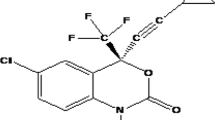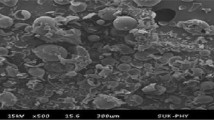Abstract
With the aim of assuring more patient compliant pharmacotherapy for acquired immuno deficiency syndrome, a formulation of the first line anti-retroviral drug, nevirapine (NVP), has been developed by encapsulating it within niosomes. Biocompatible niosomes were fabricated using a biological surfactant, tyloxapol, with variable cholesterol concentrations. Formulation with surfactant/cholesterol molar ratio 1:0.1 exhibits maximum stability and optimum hydrophobicity. Thus, it is most suitable for the entrapment of NVP and has high entrapment efficiency of 94.3%. FTIR and DSC results indicate that NVP has sufficient compatibility with the excipients of the formulation. Photoluminescence quenching measurements were employed to elucidate the position of drug molecules in niosome bilayer along with the partition coefficient. Dissolution results indicate that the efflux of drug is sustained which creates a depot effect and decreases the fluctuations in drug release. Such a versatile and improved formulation of NVP is expected to increase its therapeutic index and alleviate toxic systemic side effects while improving the quality of life and duration of survival of the patients.










Similar content being viewed by others
References
Lin JH. Role of pharmacokinetics in the discovery and development of indinavir. Adv Drug Deliv Rev. 1999;39:33–49.
Shah CA. Adherence to high activity antiretroviral therapy (HAART) in pediatric patients infected with HIV: issues and intervention in India. Pediatrics. 2007;74:55–60.
Merluzzi VJ, Hargrave KD, Labadia M, Grozinger K, Skoog M, Wu JC, et al. Inhibition of HIV-1 replication by a non-nucleoside reverse transcriptase inhibitor. Science. 1990;250:1411–3.
Larder BA. Interactions between drug resistance mutations in human immunodeficiency virus type 1 reverse transcriptase. J Gen Virol. 1994;75:951–7.
Balzarini J, Pelemans H, Karlsson A, DeClercq E, Kleim J-P. Concomitant combination therapy for HIV infection preferable over sequential therapy with 3TC and non-nucleoside reverse transcriptase inhibitors. Proc Natl Acad Sci U S A. 1996;93:13152–7.
Kontorinis N, Dieterich D. Hepatotoxicity of antiretroviral therapy. AIDS Rev. 2003;5:36–43.
Hawi A, Bell G. Preformulation studies of nevirapine, a reverse transcriptase inhibitor. Pharm Res. 1994;11(Suppl):36.
Lamson MJ, Sabo JP, Macgregor TR, Pav TW, Rowland L, Hawi A. Single dose pharmacokinetics and bioavailability of nevirapine in healthy volunteers. Biopharm Drug Dispos. 1995;20:285–91.
Kasim NA, Whitehouse M, Ramachandran C, Bermejo M, Lennernas H, Hussain AS, et al. Molecular properties of WHO essential drugs and provisional biopharmaceutical classification. Mol Pharm. 1995;1:85–96.
Ristsehel WA. Microemulsions for improved peptide absorption from the gastrointestinal tract. Methods Find Exp Clin Pharmacol. 1991;13:205–20.
Gabizon A, Goren D, Cohen R, Barenholz Y. Development of liposomal anthracyclines: from basics to clinical applications. J Control Release. 1998;53:275–9.
Navalakhe RM, Nandedkar TD. Application of nanotechnology in biomedicine. Indian J Exp Biol. 2007;45:160–5.
Liu X, Huang G. Formation strategies, mechanism of intracellular delivery and potential clinical applications of pH-sensitive liposomes. Asian J Pharm Sci. 2013;8:319–28.
Girigoswami A, Susmita D, Swati D. Fluorescence and dynamic light scattering studies of niosomes-membrane mimetic systems. Spectrochim Acta A. 2006;64:859–66.
Marianecci C, Marzio LD, Rinaldi F, Celia C, Paolino D, Alhaique F, et al. Niosomes from 80s to present: the state of the art. Adv Colloid Interf Sci. 2014;205:187–206.
US Pharmacopeia, US Pharmacopeial Convention, Rockville, 22nd Revision (USP XXII), 1990, 1434.
Kulshreshtha AK, Singh ON, Wall GM. Pharmaceutical suspensions: from formulation development to manufacturing. New York: Springer; 2010.
Scott H. Comparing the surface chemical properties and the effect of salts on the cloud point of a conventional nonionic surfactant, octoxynol 9 (Triton X-100), and of its oligomer, tyloxapol (Triton WR-1339). J Colloid Interface Sci. 1998;205:496–502.
Regev O, Zana R. Aggregation behavior of tyloxapol, a nonionic surfactant oligomer, in aqueous solution. J Colloid Interface Sci. 1999;210:8–17.
Westesen K. Phase diagram of tyloxapol and water—I. Int J Pharm. 1994;102:91–100.
Westesen K, Koch MHJ. Phase diagram of tyloxapol and water—II. Int J Pharm. 1994;103:225–36.
Tainter ML, Nachod FC, Bird JG. Alevaire as a mucolytic agent. N Engl J Med. 1955;253:764–7.
Hao Y, Zhao F, Li N, Yang Y, Li K. Studies on a high encapsulation of colchicine by a niosome system. Int J Pharm. 2002;244:73–80.
Vostrikov VV, Selishcheva AA, Sorokoumova GM, Shakina YN, Shvets VI, Savel’ev OY, et al. Distribution coefficient of rifabutin in liposome/water system as measured by different methods. Eur J Pharm Biopharm. 2008;68:400–5.
Kalynasundaram K, Thomas JK. Environmental effects on vibronic band intensities in pyrene monomer fluorescence and their application in studies of micellar systems. J Am Chem Soc. 1977;99:2039–44.
Liu T, Guo R. Preparation of a highly stable niosome and its hydrotrope-solubilization action to drugs. Langmuir. 2005;21:11034–9.
Marangoni AG. Steady-state fluorescence polarization spectroscopy as a tool to determine microviscosity and structural order in food systems. Food Res Int. 1992;25:67–80.
Zhang JA, Anyarambhatla G, Ma L, Ugwu S, Xuan T, Sardone T, et al. Development and characterization of a novel Cremophor® EL free liposome based paclitaxel (LEP-ETU) formulation. Eur J Pharm Biopharm. 2005;59:177–87.
Zhang L, Sun X, Zhang ZR. An investigation on liver-targeting microemulsions of norcantharidin. Drug Deliv. 2005;12:289–95.
Dai H, Chen Q, Qin H, Guan Y, Shen D, Hua Y, et al. A temperature-responsive copolymer hydrogel in controlled drug delivery. Macromolecules. 2006;39:6584–9.
Washington C. Drug release from microdisperse systems: a critical review. Int J Pharm. 1990;58:1–12.
Mehta SK, Jindal N. Formulation of tyloxapol niosomes for encapsulation, stabilization and dissolution of anti-tubercular drugs. Colloids Surf B: Biointerfaces. 2013;101:434–41.
van Hal DA, Bouwstra JA, van Rensen A, Jeremiasse E, de Vringer T, Junginger HE. Preparation and characterization of nonionic surfactant vesicles. J Colloid Interface Sci. 1996;178:263–73.
EL-Samaligy MS, Afifi NN, Mahmoud EA. Increasing bioavailability of silymarin using a buccal liposomal delivery system: preparation and experimental design investigation. Int J Pharm. 2006;308:140–8.
Zerrin SB, Yuksel N. Investigation of formulation variables and excipient interaction on the production of niosomes. AAPS PharmSciTech. 2012;13:826–35.
Gregoriadis G. Liposome technology. 2nd ed. Boca Raton: CRC Press; 1993.
Lurie E, Kaplun AP, Dubovskii PV, Shvets VI. Interaction of N-(2-hydroxybenzyl)-ω-amino carbonic acids, novel amphipathic fatty acid derivatives, with membrane: partition coefficients. Biochim Biophys Acta. 1995;1235:256–62.
Acknowledgments
SKM and NJ are thankful to the Council of Scientific and Industrial Research, India (CSIR), for the financial assistance.
Author information
Authors and Affiliations
Corresponding author
Rights and permissions
About this article
Cite this article
Mehta, S.K., Jindal, N. Tyloxapol Niosomes as Prospective Drug Delivery Module for Antiretroviral Drug Nevirapine. AAPS PharmSciTech 16, 67–75 (2015). https://doi.org/10.1208/s12249-014-0183-y
Received:
Accepted:
Published:
Issue Date:
DOI: https://doi.org/10.1208/s12249-014-0183-y




